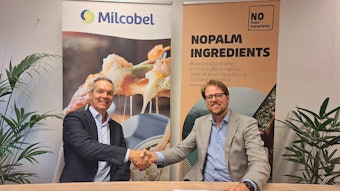“Since we live in an age of innovation, a practical education must prepare a man for work that does not yet exist and cannot yet be clearly defined.”
—Peter F. Drucker
Everyone appreciates the role innovation plays in the beauty industry, particularly those innovations involving the leveraging of information. Computers and their accompanying databases have revolutionized product development, product safety and the implementation of global regulation, and social media tools like Facebook are used by all major companies to interact with consumers. Hardly anyone can function without a smartphone and a personal hoard of apps. In fact, we’ve become so accustomed to these technological marvels that we rarely, if ever, wonder where they all came from. One short answer—New Jersey.
An Innovation Hot Spot
To understand the modern world and the role innovation plays in our lives, one must look at what has happened—and still happens—in New Jersey. Now known mostly for Snooki, The Boss and Bon Jovi, New Jersey once gave shelter to Thomas Edison and Albert Einstein. The state where Edison created the first invention factory was also the home of his Bell Labs, where William Shockley developed the transistor, and Arno Penzias and Robert Wilson first heard the cosmic background radiation left over from the big bang. In the 1940s, Morristown, New Jersey, was the home of Claude Shannon. Claude who? We’ll get there.
Innovation in New Jersey in its modern form started with Edison—a West Orange, New Jersey, resident from 1886 until his death in 1931—who established his final and most comprehensive laboratory and factory complex there. Before that, he was in Jersey cities Newark and Menlo Park. Why was Edison in New Jersey? The West Orange location was close to his financial backers in New York City, there was excellent access to rail and sea transportation, and he could purchase enough land in West Orange to build factories near the laboratory for the efficient development of the mass production and commercialization of his inventions.
If you’re an engineering geek and think Nicola Tesla was better than Edison, that fits too. Tesla’s first business, the Tesla Electric Light Company, was started in Rahway, New Jersey, in 1886. And if you move on to Marconi and early radio, he also set up his equipment in the Garden State beginning in 1899. Television? W2XCD in Passaic, New Jersey, was started by Lee DeForest in 1930, and that station broadcasted the first full-length feature film, Police Patrol, in six daily episodes in 1931.
Bell Labs was the extension of Edison’s ideas related to telephone systems—and communication in general—and many of the brightest scientists, mathematicians and engineers in the country were employed there. During World War II, many Bell Lab scientists were loaned to the government to work on specific projects, and some of the projects, such as Shockley’s work on transistors, were important enough as pure science to garner a Nobel Prize. Claude Shannon was one of Bell Labs most remarkable thinkers.
Jon Gertner’s The Idea Factory1 tells the story of Bell Labs and devotes several chapters to Shannon. He was a mathematician with a very flexible job description. His resume says a lot: Institute for Advanced Study at Princeton, Bell Labs, and when he got bored with the relatively rustic lifestyle of Murray Hill, MIT. He wrote a masters thesis at MIT on the use of electrical applications of Boolean algebra to resolve logical and numerical relationships—the basic principal behind all computer programming.
In 1948, Shannon published a paper titled A Mathematical Theory of Communication, which showed how all information from language to pictures to music could be converted to a binary code and reconstructed with no loss of fidelity. Binary is typically zeros and ones, the essence of digital technology, and computers, the Internet, smartphones, CDs, DVDs—everything that we think of as modern communication—was born in Shannon’s brain decades before engineers could apply it. Arguably, no one in the 20th century did more to create the digital world we take for granted in 2012 than Shannon.
Big in Beauty
To add to all the varied technological breakthroughs of the past, contemporary New Jersey can easily stake a claim to being at the heart of the cosmetic and fragrance industry in the U.S., and quite possibly even the world. The New York Society of Cosmetic Chemists (NYSCC) is one of the largest cosmetic chemist groups in the world, other than the national Society of Cosmetic Chemists, of which the NYSCC is a cornerstone. Also, the number of major companies with a presence in New Jersey (or just over the border, as in the case of Avon) includes Johnson & Johnson, Colgate-Palmolive, Revlon and L’Oréal. Add to that raw material suppliers, large and small fragrance houses, private label contractors, and consulting and testing laboratories, and it is hard to argue against the state’s position.
Companies most often have corporate headquarters in global cities—New York, London, Paris, Shanghai, São Paulo and so on—but most of the real work is not done in these showcase offices but in places like New Jersey. In addition to the presence of so many cosmetic companies and the NYSCC, New Jersey is also the home of the Fairleigh Dickinson University masters in cosmetic science program, one of the oldest and most highly regarded programs for formal cosmetic education in the world. Its location was always considered a key part of its success, drawing students and faculty from the highly concentrated resources of north Jersey.
Essential Events
The annual NYSCC Suppliers’ Day event is one of the biggest in the cosmetic ingredient industry that happens every year in Edison, New Jersey. In 2012, it brought in more than 8,000 attendees, and there is a connection there few may have considered—the New Jersey Convention and Exposition Center is 6.8 miles >from Menlo Park, where Edison perfected his lightbulb; 25.5 miles from 22 Mercer Street in Princeton, a modest house where Einstein lived from 1936 until his death in 1955; and 21 miles from the Bell Labs antenna where the sounds of the big bang where first heard.
In addition to its Suppliers’ Day event, the NYSCC also features a full schedule of daylong, theme-based seminars, making New Jersey an essential destination for the cosmetic industry professional. In 2013, the organization is offering the first U.S.-China cosmetic regulatory symposium at the Renaissance Hotel in Woodbridge, New Jersey, on May 16, and to accompany its full agenda of experts from the U.S. and China, the keynote speaker will be former presidential candidate and U.S. ambassador to China Jon Huntsman.
Garden State Strength
Claude Shannon made the digital age possible, because, without his genius, we may be 20 years behind in communication technology. Those 20 years could have erased the careers of Bill Gates, Steve Jobs and Mark Zuckerberg. From the point of view of the beauty industry, regulations such as REACH and the Research Institute for Fragrance Materials (RIFM) database would be much more challenging to achieve. Safety, regulations and using social networks to connect to customers all rely on the power created by binary codes. So if you live or work in New Jersey, give it another look as a cradle of the modern age. And if you come to visit either an NYSCC event or one of the many of the cosmetic companies that call it home, remember the surrounding towns also were home for many of the great minds of science and technology.
An appropriate way to honor Shannon is to use some of the tools he helped make possible—computers, the Internet, digital video—to view an excellent summary of his career via YouTube2. Yes, YouTube can be a great place for serious scientific videos—once you get past the cats that can play the piano.
Reference
- J Gertner, The Idea Factory: Bell Labs and the Great Age of American Innovation, The Penguin Press, New York, (2012)
- Claude Shannon—Father of the Information Age, www.youtube.com/watch?v=z2Whj_nL-x8 (Accessed Oct 12, 2012)
Steve Herman is president of Diffusion LLC, a consulting company specializing in regulatory issues, intellectual property, and technology development and transfer. He is a principal in PJS Partners, offering formulation, marketing and technology solutions for the personal care and fragrance industry. He is the New York Society of Cosmetic Chemist’s 2013 Chapter Chairman and an adjunct professor in the Fairleigh Dickinson University Masters in Cosmetic Science program. He is also a Fellow in the Society of Cosmetic Chemists.










